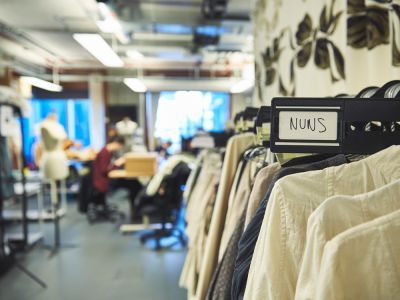Behind the Scenes: Costume Call

With more than 22 years’ experience in the field of costume, including a Master’s Degree in History and Culture of Fashion, you’d forgive Vanessa Lingham if her passion for costume had waned.
But it’s clear the passion burns as bright now as it has ever done. “I just love the challenge of helping students make it happen, literally taking a design from page to stage,” says Lingham, currently a doctoral student and Lecturer in Costume at Guildhall, researching costume design. “My working background is in film and television, covering most fields of costume – styling, costume design, supervision, standby, you name it – and I think that’s why I enjoy teaching, because this too is so broad-based.” Lingham’s focus is teaching practices in costuming, as well as mentoring the students as they go through the School.
The costume sourcing process begins in Guildhall’s costume store, located about 15 minutes off campus. It’s a small space but an essential resource, filled with donations and replenished regularly with previous productions’ old costumes. It’s where Lingham’s students turn for inspiration. “We use the costume store for formal teaching, such as fashion history, and we introduce students to the range of practices in costuming,” says Lingham.
“I also like to make the students aware of the context of a costume: to know where those types of people would have got their clothes, what fabrics were available and so on.”
In the spring term, the focus was on two plays, Detroit, a timeless 21st century world within a generic North American suburb, and Fury, a contemporary production set in London. With the two productions running concurrently, it was important that the students had spent a fair bit of time looking at the costume line-up before the fitting with the designer, so they had a good understanding of what was available and priority choices.
“Each designer works differently so each fitting is different. Some draw designs, some just have an idea, so we have to work closely with them to interpret their ideas and come up with some creative solutions. The ones I enjoy most are the designers who inspire me and challenge us to interpret that character and their costume. As part of our teaching we help students adapt to different working practices and shape these crucial moments to benefit artists and the art.”
“On a production of the oratorio, San Giovanni, for example, the costume designer had in mind a very particular look for the character, Herodiade. She showed us a picture of a supermodel wearing a long, gold, sequinned, backless haute couture dress – and wanted us to match that exactly. The students were brilliant and really rose to the challenge. It took them a few weeks, but the results were incredible, and it became one of our department’s ‘go-to’ exhibition pieces.” In fact, while it was on display at Guildhall, a television company got in touch to hire it for set dressing, so it ended up being featured in a shop window in the ITV drama, Mr Selfridge.
The spring term was very intensive, says Lingham, especially with the overlap between productions. For the dramas, students get a fortnight of preparation, a week of fittings, a week of alterations, a week of rehearsals, and a week of performance and wrap. But it’s never straightforward. “As ever, we had lots of changes during rehearsal. This can be down to various reasons, such as a designer’s preference or the shape and fit for actors. Lighting quite often affects change as garments we thought looked one colour in daylight look very different on stage under lights. Sometimes costumes need to be quick-changed, so alterations happen to ensure garments are quick and easy to take off and put on.”
But, for Lingham, it’s that moment of the fitting that is still completely magical. “You have a rail of clothes sourced from all over the place and then the artist puts them on. That moment is electric, the best feeling ever. I’ve seen actors change into the character within a split second – and it’s all to do with how costume transforms things. That fitting moment makes it all worthwhile.”
This article first featured in the Spring/Summer 2019 edition of the Guildhall magazine, PLAY, and was written by YBM for the Guildhall School.